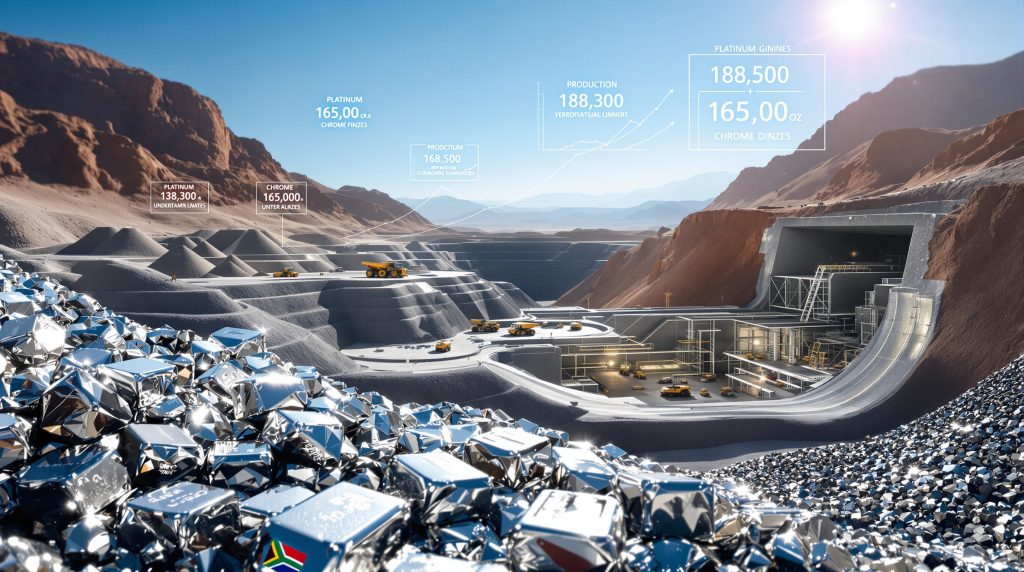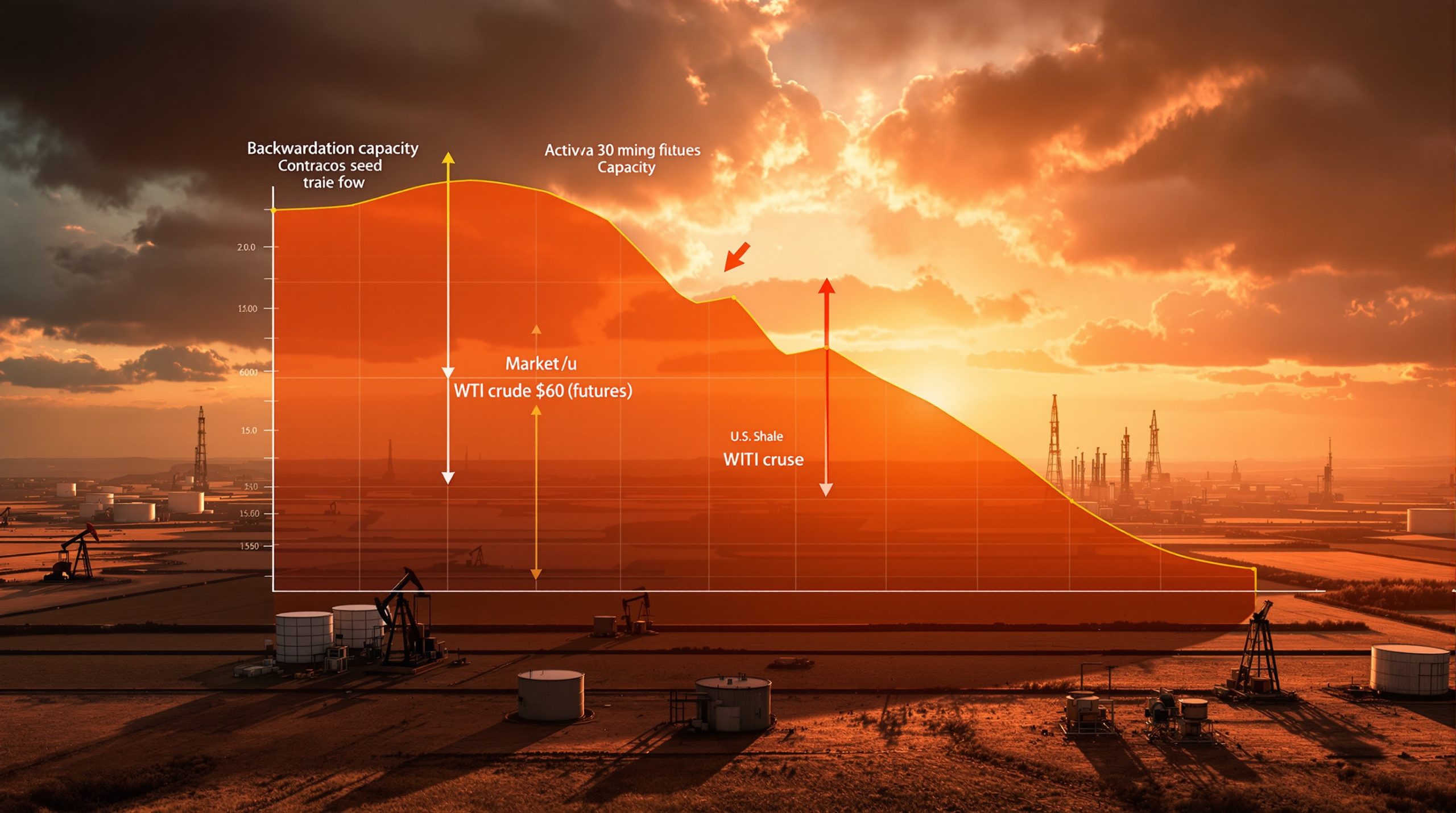Tharisa's PGM Production Targets for 2026: Strategic Growth and Underground Expansion
Tharisa, a prominent mining company, has established ambitious production targets for platinum group metals (PGMs) for the 2026 financial year. The company aims to produce between 145,000 and 165,000 ounces of PGMs, representing a strategic increase from the 138,300 ounces produced in the 2025 financial year. Simultaneously, Tharisa is targeting chrome concentrate production of 1.5-1.65 million tonnes for 2026, building upon its 2025 output of 1.56 million tonnes.
These forward-looking production targets reflect the company's confidence in its operational capabilities and strategic investments, particularly the transformative $547 million underground mining initiative at its flagship Tharisa mine in South Africa's North West province. The expansion project represents a significant shift in the company's long-term strategy and demonstrates management's commitment to sustainable production growth.
What Drove Tharisa's 2025 Production Performance?
The 2025 financial year saw Tharisa produce 138,300 ounces of PGMs and 1.56 million tonnes of chrome concentrates. While these figures represented a decline from the 145,100 ounces of PGMs and 1.7 million tonnes of chrome concentrates produced in 2024, the company demonstrated resilience with a strong fourth-quarter performance.
PGM production in Q4 2025 increased substantially by 19.7% quarter-on-quarter to 41,300 ounces, while chrome production rose 2.9% to 407,200 tonnes. This robust finish to the year was driven by improvements across all key operational metrics, including:
- Enhanced mining efficiency
- Increased milling performance
- Improved ore grade
- Higher metal recovery rates
The company's ability to close the year with strengthened production metrics suggests operational improvements that will provide critical support for its ambitious 2026 targets.
Recovery Through Operational Excellence
The fourth quarter recovery wasn't merely coincidental but rather the result of deliberate operational improvements. Industry analysts note that Tharisa's focus on process optimization and operational discipline helped overcome earlier challenges in the financial year.
Mining analysts from Standard Bank pointed out that the company's implementation of advanced grade control systems likely contributed to the improved ore grades seen in the latter part of 2025. Additionally, the expansion of milling capacity at key processing plants provided the foundation for higher throughput volumes.
Tharisa's $547 Million Underground Mining Investment
Strategic Transition to Underground Operations
The cornerstone of Tharisa's production growth strategy is its $547 million investment in underground mining at the flagship Tharisa mine. This significant capital commitment represents a transformative shift in the company's operational approach and underscores management's confidence in the long-term viability of the resource.
Key aspects of the underground mining innovations include:
- First ore expected in Q2 2026
- Extension of mine life beyond 2034
- Transition to mechanized mining methods
- Enhanced safety protocols and technologies
- Improved operational efficiencies
The underground development represents a pivotal evolution in Tharisa's operational strategy, transitioning from its historical focus on open-pit mining to a more sustainable long-term approach that will access deeper reserves.
Production Capacity Enhancement Timeline
The underground expansion is designed to progressively increase Tharisa's production capacity over the coming years:
| Timeline | PGM Production Target | Chrome Concentrate Target |
|---|---|---|
| 2026 FY | 145,000-165,000 oz | 1.5-1.65 million tonnes |
| By 2033 | >200,000 oz annually | >2 million tonnes annually |
This phased approach allows for a measured transition while maintaining production stability and managing capital allocation prudently. The company expects a gradual ramp-up of underground production as development progresses, with full production capacity targeted for 2033.
Technical Challenges and Innovations
The transition to underground mining presents unique technical challenges that Tharisa must overcome. The geological structure of the Tharisa deposit features a complex series of chromitite layers that require specialized mining techniques to extract efficiently.
Mining technology experts have highlighted that the company's planned implementation of battery-electric vehicles (BEVs) for underground operations will not only reduce ventilation requirements but also lower operational costs over the mine's extended life. The use of advanced rock mechanics monitoring systems will also be crucial in ensuring ground stability as the operation extends to deeper levels.
How Do Market Conditions Support Tharisa's Expansion?
PGM Market Dynamics
The PGM market, particularly platinum, has demonstrated robust performance throughout 2025, creating a favorable pricing environment for producers like Tharisa. Key market factors include:
- Persistent supply-demand deficits
- Constrained global production
- Tightening above-ground stocks
- Strong industrial demand fundamentals
The average PGM basket price increased by 18.6% to $1,615/oz for the 2025 financial year, compared to $1,362/oz in 2024. The fourth quarter saw an even more dramatic 24.1% quarter-on-quarter increase to $1,953/oz, providing strong revenue support for Tharisa's operations and investment plans.
While platinum has shown particular strength, palladium faces what the company describes as a more delicate balance. The minor PGM metals continue to benefit from healthy supply-demand fundamentals, contributing to the overall positive price outlook.
Chrome Market Conditions
The chrome market has demonstrated stability despite some price moderation. The average metallurgical-grade chrome concentrate price decreased by 11% year-on-year to $266/t for the 2025 financial year, with Q4 prices averaging $276/t compared to $293/t in Q3.
Despite this modest price reduction, Tharisa maintains that the market remains structurally balanced, with:
- Sustained demand from the stainless steel sector
- Constrained supply growth globally
- Balanced inventory levels
This market equilibrium provides a stable foundation for Tharisa's chrome production targets and contributes to the overall economics of its mining operations.
Technological Demand Drivers
Beyond traditional applications in automotive catalysts and jewelry, PGMs are experiencing growing demand from emerging technologies. Platinum's role in hydrogen fuel cells and electrolysis applications for green hydrogen production is expanding, creating new market segments that could absorb additional supply.
According to recent research from Johnson Matthey, the green hydrogen sector alone could consume up to 600,000 ounces of platinum annually by 2035 if the industry achieves its growth projections. This emerging demand vector provides additional support for Tharisa's long-term production growth strategy.
What Safety and Operational Improvements Support Tharisa's Growth?
Tharisa's production targets are underpinned by its commitment to operational excellence and safety. The company reported a pleasing safety performance across all operations during 2025, highlighting the effectiveness of its safety protocols and continuous improvement initiatives.
Operational enhancements supporting the company's growth trajectory include:
- Investment in fixed assets to ensure operational efficiency
- Implementation of advanced mining technologies
- Enhanced processing capabilities
- Improved recovery rates
- Strengthened ground control measures
These operational improvements provide the foundation for Tharisa's ambitious production targets and support the company's transition to underground mining operations.
Digital Transformation Initiatives
A key component of Tharisa's operational improvement strategy is its investment in digital technologies and data-driven mining operations. The company has implemented advanced fleet management systems that optimize haulage cycles and reduce fuel consumption. Real-time monitoring of processing plant parameters allows for immediate adjustments to maximize metal recovery.
Mining technology consultants have noted that Tharisa's implementation of predictive maintenance algorithms has reduced unplanned downtime by approximately 15% across key production equipment. This improvement in asset utilization directly translates to higher throughput and production volumes.
Environmental and Sustainability Considerations
Disclaimer: Environmental performance metrics and sustainability initiatives described here represent industry best practices but specific implementation details should be verified through Tharisa's sustainability reporting.
As the company transitions to underground operations, there are notable environmental advantages compared to open-pit mining. These include reduced visual impact, decreased dust emissions, and a smaller surface footprint for waste rock storage.
Tharisa has also invested in water conservation initiatives, including closed-circuit water systems that minimize freshwater consumption and reduce the risk of environmental contamination. Energy efficiency improvements, such as variable frequency drives on pumps and fans, help reduce the operation's carbon footprint while lowering operating costs.
How Does Tharisa's Zimbabwe Expansion Factor Into Growth Plans?
While the flagship Tharisa mine in South Africa remains the company's primary focus, Tharisa continues to advance the development of its Karo PGM project in Zimbabwe. This represents a geographic diversification strategy that complements the company's South African operations.
The company describes material advances at Karo despite a measured capital allocation approach, indicating that this project forms part of its broader growth strategy. Management emphasizes that expansion aspirations are carefully calculated and aligned with disciplined capital allocation policy, ensuring that investments prioritize:
- Long-term value creation
- Balance sheet strength
- Sustainable shareholder returns
This balanced approach to growth across multiple jurisdictions helps mitigate operational and geopolitical risks while creating multiple avenues for production expansion.
Zimbabwe's Great Dyke Geological Advantage
The Karo project is located on Zimbabwe's Great Dyke, a geological feature renowned for its rich PGM mineralization. Geological studies indicate that the Great Dyke contains some of the most consistent PGM grades globally, with favorable ratios of platinum to palladium and significant rhodium credits.
Mining geologists point out that the Great Dyke's relatively shallow depth of mineralization compared to South Africa's Bushveld Complex offers potential cost advantages. The estimated average depth of 200-300 meters for initial mining areas could translate to lower development and operating costs compared to deeper operations in South Africa.
Regulatory and Investment Climate
Zimbabwe's mining sector has undergone significant regulatory changes in recent years aimed at attracting foreign investment. The country's mining legislation now provides improved stability for international investors, though challenges remain in terms of foreign currency regulations and infrastructure limitations.
Economic analysts suggest that Tharisa's measured approach to the Karo project reflects a pragmatic assessment of these regulatory factors. By developing the project in phases and aligning capital deployment with demonstrated regulatory stability, the company is managing risk while maintaining the option value of this significant resource.
What Are the Long-Term Implications of Tharisa's Production Strategy?
Tharisa's production targets for 2026 represent more than short-term operational goals. They form part of a comprehensive long-term strategy to enhance the company's position in the PGM and chrome markets. The transition to underground mining at the Tharisa mine will extend operational life beyond 2034, creating a sustainable production platform for decades to come.
The company's strategic investments are designed to:
- Unlock the full potential of its resource base
- Enhance operational efficiency and productivity
- Secure long-term value for stakeholders
- Capitalize on favorable market fundamentals
- Strengthen its competitive position
By balancing near-term production targets with long-term strategic investments, Tharisa is positioning itself for sustainable growth in an industry characterized by cyclical markets and evolving supply-demand dynamics.
Industry Positioning and Competitiveness
Tharisa's underground expansion positions the company among the more forward-thinking mid-tier PGM producers. While major producers like Anglo American Platinum and Impala Platinum have long histories of underground mining, Tharisa's transition represents a significant evolution for a company that began as primarily an open-pit operator.
Mining industry consultants note that Tharisa's integrated business model, which includes both PGM and chrome production from the same ore body, provides unique economic advantages. The chrome co-product significantly reduces the effective cost of PGM production, enhancing margins and providing a buffer against PGM price volatility.
Technology and Innovation Leadership
The underground expansion project creates an opportunity for Tharisa to implement leading-edge technologies from inception rather than retrofitting existing operations. This greenfield advantage enables the company to design systems optimized for safety, productivity, and cost-efficiency.
Mining technology experts highlight that Tharisa's planned implementation of semi-autonomous drilling and loading equipment could set new benchmarks for underground productivity in the PGM sector. The integration of AI in mining technology with production planning systems has the potential to optimize metal recovery and reduce dilution.
Conclusion: Tharisa's Path to Enhanced PGM Production
Tharisa's 2026 production targets of 145,000-165,000 ounces of PGMs and 1.5-1.65 million tonnes of chrome concentrates represent a strategic milestone in the company's growth journey. These targets are supported by:
- A transformative $547 million investment in underground mining
- Strong operational performance in the latter part of 2025
- Favorable PGM market fundamentals
- Balanced chrome market conditions
- Ongoing safety and operational improvements
- Geographic diversification through the Karo project
As the company progresses toward first ore from its underground operations in Q2 2026, it is laying the groundwork for sustainable long-term production growth that will ultimately target more than 200,000 ounces of PGMs and over 2 million tonnes of chrome concentrates annually by 2033.
The company's disciplined approach to capital allocation, commitment to operational excellence, and strategic vision position it to capitalize on the structural advantages of the PGM and chrome markets while delivering long-term value to shareholders. Furthermore, the mining industry evolution demonstrates how companies like Tharisa are adapting to changing market conditions and technological opportunities, while also prioritizing mine reclamation innovations to ensure sustainable operations.
Important Disclaimer: This article contains forward-looking statements about production targets, market conditions, and project developments. Actual results may differ materially from projections due to various factors including market fluctuations, operational challenges, regulatory changes, and other risks inherent to the mining industry. Readers should conduct their own due diligence before making investment decisions based on the information presented.
Want to Identify the Next Major Mineral Discovery?
Discovery Alert's proprietary Discovery IQ model instantly notifies investors of significant ASX mineral discoveries, turning complex data into actionable insights for both short-term traders and long-term investors. Explore why major mineral discoveries can lead to substantial market returns by visiting the Discovery Alert discoveries page and position yourself ahead of the market.




